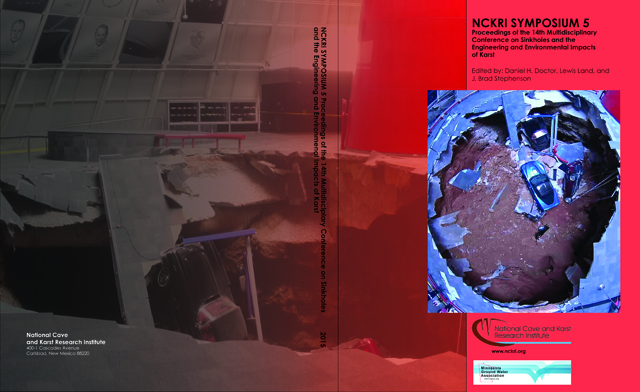Publication Date
2015
Abstract
The bedrock aquifer of the Driftless Area of northwestern Illinois is Ordovician-age Galena Dolomite. Previous work by the authors and others showed that the geology and hydrogeology of this area fall well within the definition of karst. Bedrock in the study area has been shown to be extensively fractured and creviced; karst features in the county are dominated by solution-enlarged crevices from 0.4 inches to 3 feet wide within most road cuts and quarries examined. Other karst features include cover-collapse sinkholes ranging from 3 to 25 feet in diameter overlying Galena Dolomite, karst springs and crevice caves. A preliminary evaluation of the groundwater quality Jo Daviess County in the Driftless Area of northwestern Illinois was conducted to assess the susceptibility of the Galena Dolomite aquifer to surface-borne contaminants. This was done by evaluating available groundwater quality data from published sources and the Illinois State Water Survey Groundwater Quality Database (i.e., wells and springs), and also by sampling 11 private wells across the county and analyzing for inorganic chemistry, dissolved organic carbon, stable isotopes and tritium. We found that groundwater in the study area is of a Ca-Mg-HCO3 type as would be expected for an aquifer dominated by dolomite. In parts of the county, the upper part of the carbonate-hosted aquifer contains elevated concentrations of chloride, nitrate and potassium. Likely contamination sources are anthropogenic and include road salt, potash and nitrogen fertilizers, and livestock/human waste. The presence of these contaminants suggests movement of surface-borne contaminants into the aquifer and into wells screened at depths ranging from 65 to 150 feet. Historic data reveal stratification of surface-borne contaminants (greatest concentrations nearest the surface) within the fractured and creviced aquifer to a depth of about 300 feet. Nitrate-N (NO3-N) concentrations in karst springs are typically between 10 and 13 mg/L, but can exceed 30 mg/L. Because the predominant land use in the study area is row-crop agriculture, it is likely that much of the NO3-N is derived from N-fertilizer. In the 11 water well samples, NO3-N concentrations ranged from < 0.04 (detection limit) to 5.4 mg/L and concentrations were clearly related to tritium. Specifically, NO3-N concentrations in groundwater containing less than 3 TU were below detection (0.04 mg/L), and above 3 TU, NO3-N and tritium were positively correlated. This relationship suggests a nonpoint source of N and denitrification within the aquifer. Chloride (Cl-) concentrations in karst springs were between 15 and 25 mg/L above background concentrations (1 to 15 mg/L). Water wells samples had lower Cl- concentrations with 7 of 11 wells below background (ca. 15 mg/L), although the concentration in the shallowest well was 110 mg/L and was probably derived from road salt. Overall, the groundwater quality of the Galena Dolomite aquifer in Jo Daviess County is what would be expected in an open, dolomite-dominated karst aquifer.
Rights Information
DOI
http://dx.doi.org/10.5038/9780991000951.1094
Included in
Driftless Area Karst of Northwestern Illinois and its Effects on Groundwater Quality
The bedrock aquifer of the Driftless Area of northwestern Illinois is Ordovician-age Galena Dolomite. Previous work by the authors and others showed that the geology and hydrogeology of this area fall well within the definition of karst. Bedrock in the study area has been shown to be extensively fractured and creviced; karst features in the county are dominated by solution-enlarged crevices from 0.4 inches to 3 feet wide within most road cuts and quarries examined. Other karst features include cover-collapse sinkholes ranging from 3 to 25 feet in diameter overlying Galena Dolomite, karst springs and crevice caves. A preliminary evaluation of the groundwater quality Jo Daviess County in the Driftless Area of northwestern Illinois was conducted to assess the susceptibility of the Galena Dolomite aquifer to surface-borne contaminants. This was done by evaluating available groundwater quality data from published sources and the Illinois State Water Survey Groundwater Quality Database (i.e., wells and springs), and also by sampling 11 private wells across the county and analyzing for inorganic chemistry, dissolved organic carbon, stable isotopes and tritium. We found that groundwater in the study area is of a Ca-Mg-HCO3 type as would be expected for an aquifer dominated by dolomite. In parts of the county, the upper part of the carbonate-hosted aquifer contains elevated concentrations of chloride, nitrate and potassium. Likely contamination sources are anthropogenic and include road salt, potash and nitrogen fertilizers, and livestock/human waste. The presence of these contaminants suggests movement of surface-borne contaminants into the aquifer and into wells screened at depths ranging from 65 to 150 feet. Historic data reveal stratification of surface-borne contaminants (greatest concentrations nearest the surface) within the fractured and creviced aquifer to a depth of about 300 feet. Nitrate-N (NO3-N) concentrations in karst springs are typically between 10 and 13 mg/L, but can exceed 30 mg/L. Because the predominant land use in the study area is row-crop agriculture, it is likely that much of the NO3-N is derived from N-fertilizer. In the 11 water well samples, NO3-N concentrations ranged from < 0.04 (detection limit) to 5.4 mg/L and concentrations were clearly related to tritium. Specifically, NO3-N concentrations in groundwater containing less than 3 TU were below detection (0.04 mg/L), and above 3 TU, NO3-N and tritium were positively correlated. This relationship suggests a nonpoint source of N and denitrification within the aquifer. Chloride (Cl-) concentrations in karst springs were between 15 and 25 mg/L above background concentrations (1 to 15 mg/L). Water wells samples had lower Cl- concentrations with 7 of 11 wells below background (ca. 15 mg/L), although the concentration in the shallowest well was 110 mg/L and was probably derived from road salt. Overall, the groundwater quality of the Galena Dolomite aquifer in Jo Daviess County is what would be expected in an open, dolomite-dominated karst aquifer.

